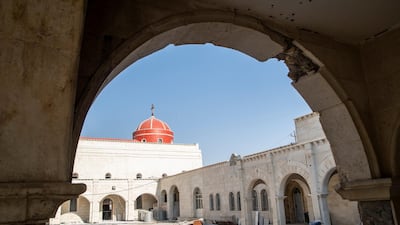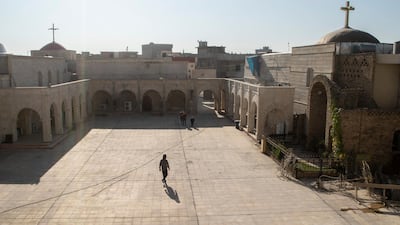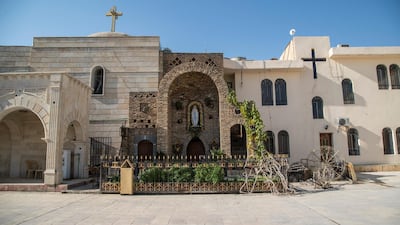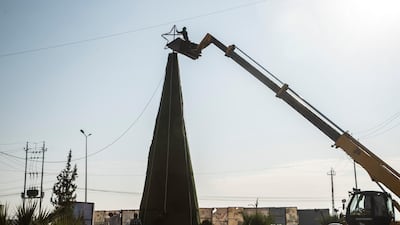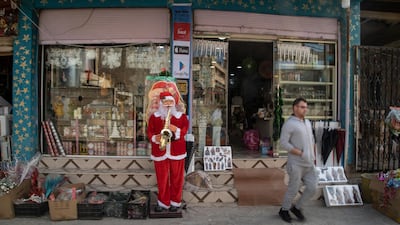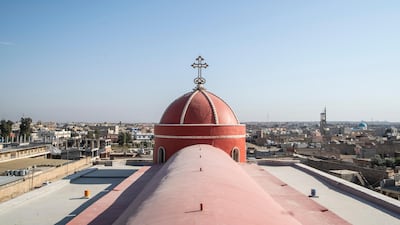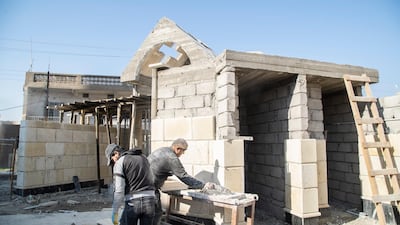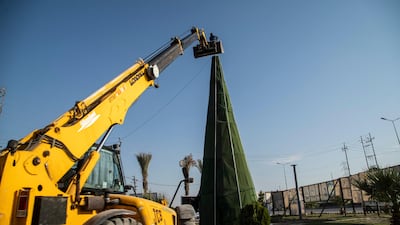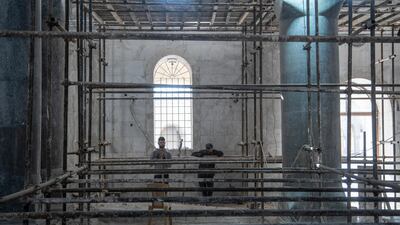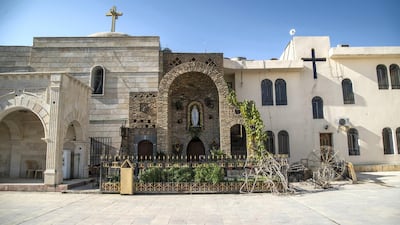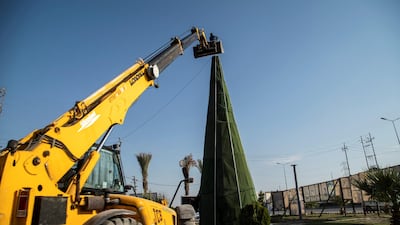It is noisy up on the scaffolding inside the main nave of Saint Mary Al Tahira church. Workers push wheelbarrows of debris outside to the inner courtyard as the sound of a circular saw snarls and rattles while cutting up white alabaster.
Most of the interior walls of this Syriac-Catholic church in the northern Iraqi town of Qaraqosh are snow white with the fresh gypsum, but marks from ISIS’ reign of terror are still obvious.
Parts of the walls are blackened by soot caused by arson, and some marble pillars are peppered with bullet holes. The bullets themselves can still be pulled from the stonework of the courtyard, which was used as a makeshift firing range by the group.
"The completion of restoration work will have a symbolic value," Father Charbel Issou told The National. "It will mark the end of the Daesh era and a start a new one after all the sufferings that we endured," he said, using the Arabic acronym for ISIS.
But four years after the barbaric group was chased out, the once vibrant Christian community in the religiously-mixed Nineveh Plain – where Qaraqosh is the biggest Christian town – is still plagued by fear and problems.
“We are afraid of our own shadow now,” Abdul-Munim Afram Ishaq said, enjoying a sunny day out in a park while sharing a concrete bench with two neighbours.
“Anyone who can afford to leave Iraq will do without any hesitation,” Mr Ishaq, 56, said.
“There is no government that can protect you, we are surrounded by different problems and woes,” the father of seven added.
When Saddam Hussein was in power, Christians lived in peace among the country’s Muslim majority and enjoyed protection from both the government and society.
But with the rise of extremism after the 2003 US-led invasion that toppled the long-time dictator, targeted killings and kidnappings for ransom began against the community, forcing many to flee the country.
The houses and businesses of those who fled have since been taken illegally, mainly by gangs who forge property papers.
The deadliest assault the community endured was in October 2010 when an affiliate of Al Qaeda in Iraq stormed into Our Lady of Salvation Catholic church in Baghdad during Sunday night mass, killing at least 58 people.
Four years later, thousands of Christians fled their ancestral home in Mosul and surrounding areas as ISIS militants advanced, confiscating their homes, burning churches and forcing them either to convert to Islam or pay a special tax.
Data on the number of Christians in Iraq is not available, but the community’s leaders estimate that only around 500,000 remain from around 1.5 million before 2003.
In early August 2014, loud explosions and shootings were the alarm for Mr Ishac and others that ISIS was advancing to Qaraqosh.
They fled with other families, joining the nearly 120,000 Christians who ended up in camps, tents on the streets or rented properties in the northern Kurdish region.
“We fled overnight with the clothes we were wearing. It was a black day for all of us,” Mr Ishac recalled.
“The town was a flourishing one, but when we returned, we found only devastation and vandalised and burned-out houses,” he added.
His family was the first to return to the town when it was liberated in October 2016. He managed to rebuild his home with financial aid from the church.
Before 2014, he worked as a guard for the Nineveh local government. Now, he’s part of a local force to protect churches.
Like many Iraqis, he complains of debilitated public services and a delay in salary amid the harsh economic situation caused by plummeting oil prices in the international market that left the government struggling with paying salaries and social benefits.
Like other Qaraqosh residents, he’s eagerly awaiting the day Al Tahira church reopens, as it holds a special place in their hearts.
To cope with the increasing number of Christians, the farmers of Qaraqosh started building Al Tahira church in 1932 from their own money, setting aside from their harvest every year. It was inaugurated in 1948.
It is now considered the largest Syriac-Catholic church in the Middle East.
Like other churches and Christian properties, it was badly damaged and burned down when ISIS blew through the town. Valuable paintings, manuscripts, prayer books, religious objects and furniture were also lost, as well as the clock tower which was blown up.
Among the precious objects that were lost are a cross of pure silver dated back to 1600AD – which survived the 1743 Nadir Shah campaign in the area that plundered and destroyed churches and monasteries – and paintings of the Virgin Mary, Mr Issou lamented.
But the church and its members do not want to forget the past, however painful.
A hall at Al Tahira will be dedicated to displaying damaged parts of the church and other objects. Discussions are ongoing about keeping the bullet-riddled yard as it is to show “the marks of a dark age,” he continued.
The church is slated to reopen in March, to host Pope Francis when he visits Qaraqosh, Mr Issou added. It will be the pontiff's last stop on a four-day visit to Iraq.
Announced by the Vatican last week, it will be the first papal visit to Iraq with stops in Baghdad, and the capital of the Kurdish region Erbil, as well as Ur, the birthplace of Abraham, and Mosul.
The Christian population in Qaraqosh sees hope in the papal visit, but it has also raised fears of violence.
“We are happy to hear that the Pope will be among us to strengthen us and our faith,” Mr Ishac said.
“But we are concerned about his safety as some Muslims have started a harassment campaign on social media, insulting us, Christianity and the Vatican,” he added.
Many of the public buildings and streets in Qaraqosh have been restored and the majority of the houses brought back to a habitable condition. Works are also under way to rehabilitate the town’s sewerage systems and nearly one-third of the nearly 160 poultry projects.
The Mayor of Hamdaniya district, where Qaraqosh is located, Essam Bahnam Matti, said nearly 50 per cent of Christians and 90 per cent of other groups have returned to their areas since ISIS was driven out.
In Qaraqosh, more than 4,300 were partially or completely burned, while more than 140 houses were demolished, Mr Matti added.
“We are deeply grieved that we have lost big numbers [of Christians],” Mr Matti said.
He called on the federal government to ease regulations in regard to investment to encourage local and foreign investors to help create job opportunities for residents.
Like many of his community, stationery store owner Samir Habib Abouch says Iraq needs far beyond a reconstruction of buildings and services.
“The most important thing is to rehabilitate the souls, rather than the stones … in order to spread peace and love instead of terrorism and killings,” he said, his tone in opposition to the joyous Santa Claus toys, trees and decorations surrounding him in his shop. Sales are down.
